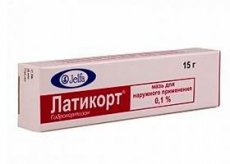Medical expert of the article
New publications
Preparations
Laticort
Last reviewed: 23.04.2024

All iLive content is medically reviewed or fact checked to ensure as much factual accuracy as possible.
We have strict sourcing guidelines and only link to reputable media sites, academic research institutions and, whenever possible, medically peer reviewed studies. Note that the numbers in parentheses ([1], [2], etc.) are clickable links to these studies.
If you feel that any of our content is inaccurate, out-of-date, or otherwise questionable, please select it and press Ctrl + Enter.

Laticort is a corticosteroid used to treat dermatological diseases.
 [1]
[1]
Indications of the laticorta
It is used to eliminate uninfected skin lesions that appear in the form of enhanced keratinization, and are also sensitive to local SCS: seborrheic or atopic type dermatitis, eczema contact form, psoriasis with erythroderma, and red lichen and insect bites.
Release form
The release occurs in the form of an ointment, cream, and also lotion (all forms 0.1%). Ointment and cream - in tubes of 15 g (1 tube in a pack), and lotion - in flakonchikah with a dispenser of 20 ml (1 bottle in a pack).
Pharmacodynamics
The medicine is applied externally. Strengthens the walls of capillaries and has a strong antipruritic, anti-inflammatory, as well as antiexudative and anti-allergic action.
Prevents the activity of the phospholipase element, due to which the inhibition of leukotriene binding occurs. It interferes with the movement of leukocytes with lymphocytes into the area of inflammation, suppresses the proteolytic influence of tissue kinin, and at the same time prevents the appearance of fibroblasts, as well as connective tissues in the area of inflammation. In addition, the drug reduces hyperemia and manifestations of intolerance, as well as the processes of proliferation and exudation occurring in the inflammatory region.
Pharmacokinetics
After treatment of the cutaneous surface, the drug is rapidly absorbed into the interior. Absorption into the circulatory system is rather weak, although if the drug is applied to large areas of the body or used for a long time in combination with a hermetically sealed bandage, it can have a systemic effect. The laticort is able to accumulate inside the horny skin layer. Absorption of hydrocortisone is more pronounced in children.
Inside the epidermis, the biotransformation of the active substance takes place, and the part that is absorbed inside is exposed to hepatic metabolism, which produces butane acid.
Decay products, as well as hydrocortisone are excreted from the body together with bile, and also through the kidneys.
Dosing and administration
It is required to handle a small amount of the drug in the affected area of the skin - rub it, lightly massaging. The procedure should be carried out 1-3 times a day in 1-3 weeks. It is necessary to closely monitor the size of the daily dose of drugs - it is impossible that it exceeds 2 g.
If the focus of inflammation is located on the elbows or knees (plaques of psoriasis), it is recommended to use hermetic bandages.
For children, Laticort is prescribed by short courses, for a maximum of 1 week, and treatment is administered under the supervision of a doctor.
On the face the medicine needs to be applied very carefully, because it can cause skin atrophy, perioral dermatitis, and in addition telangiectasia. It is also necessary to prevent the drug from entering the eyes.
If there is no improvement after 7 days of drug use (or worsening is noted), you should discuss this with your doctor.
 [2]
[2]
Use of the laticorta during pregnancy
Use Laticort during pregnancy (especially in the 1st trimester) is prohibited.
When breastfeeding, you can not use the drug systematically - only small parts of the skin can be treated (it is forbidden to apply it to the breast).
Contraindications
The main contraindications:
- infectious lesions of the skin (fungal or bacterial origin);
- skin lesions of a tubercular or syphilitic nature;
- rosacea or mycosis;
- use of drugs for a certain period of time after the vaccination procedure;
- infants less than 6 months of age;
- presence of tumors, ulcers or wounds on the skin;
- sensitivity to Latticort.
Caution is required when using people with diabetes.
Side effects of the laticorta
Usually the medicine is transferred without complications. Sometimes you can expect the appearance of irritation on the skin, and in case of prolonged use on extensive areas of the body - the development of glucocorticoid effects of the systemic type.

Overdose
Signs of poisoning appear very rarely, mainly as a result of prolonged treatment of large areas of the skin - in this case, there are symptoms of hypercorticism.
Storage conditions
The laticort is kept in the usual conditions for medicines. The temperature should not be above 25 ° C.
 [3]
[3]
Special instructions
Reviews
Laticort receives mostly positive reviews. High efficacy of the drug in the treatment of red lichen planus, as well as various dermatitis, is noted. There is no information on the development of side effects resulting from its use.
Shelf life
Laticorts are allowed to be used during the 3 years from the date of release of the medicinal product.

Attention!
To simplify the perception of information, this instruction for use of the drug "Laticort" translated and presented in a special form on the basis of the official instructions for medical use of the drug. Before use read the annotation that came directly to medicines.
Description provided for informational purposes and is not a guide to self-healing. The need for this drug, the purpose of the treatment regimen, methods and dose of the drug is determined solely by the attending physician. Self-medication is dangerous for your health.

